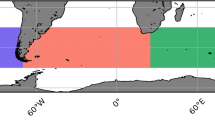Abstract
The retreat of the Arctic ice edge implies that global ocean surface wave models have to be extended at high latitudes or even to cover the North Pole in the future. The obstacles for conventional latitude-longitude grid wave models to cover the whole Arctic are the polar problems associated with their Eulerian advection schemes, including the Courant-Friedrichs-Lewy (CFL) restriction on diminishing grid length towards the Pole, the singularity at the Pole and the invalid scalar assumption for vector components defined relative to the local east direction. A spherical multiple-cell (SMC) grid is designed to solve these problems. It relaxes the CFL restriction by merging the longitudinal cells towards the Poles. A round polar cell is used to remove the singularity of the differential equation at the Pole. A fixed reference direction is introduced to define vector components within a limited Arctic part in mitigation of the scalar assumption errors at high latitudes. The SMC grid has been implemented in the WAVEWATCH III model and validated with altimeter and buoy observations, except for the Arctic part, which could not be fully tested due to a lack of observations as the polar region is still covered by sea ice. Here, an idealised ice-free Arctic case is used to test the Arctic part and it is compared with a reference case with real ice coverage. The comparison indicates that swell wave energy will increase near the ice-free Arctic coastlines due to increased fetch. An expanded Arctic part is used for comparisons of the Arctic part with available satellite measurements. It also provides a direct model comparison between the two reference systems in their overlapping zone.












Similar content being viewed by others
References
Ardhuin F, Rogers E, Babanin A, Filipot JF, Magne R, Roland A, Van der Westhuysen A, Queffeulou P, Lefevre JM, Aouf L, Collard F (2010) Semiempirical dissipation source functions for ocean waves. Part I: definition, calibration and validation. J Phys Oceanogr 40:1917–1941
Booij N, Holthuijsen LH (1987) Propagation of ocean waves in discrete spectral wave models. J Comput Phys 68:307–326
Li JG (2008) Upstream non-oscillatory advection schemes. Mon Weather Rev 136:4709–4729
Li JG (2011) Global transport on a spherical multiple-cell grid. Mon Weather Rev 139:1536–1555
Li JG (2012) Propagation of ocean surface waves on a spherical multiple-cell grid. J Comput Phys 231:8262–8277
Li JG, Holt M (2009) Comparison of Envisat ASAR ocean wave spectra with buoys and altimeter data via a wave model. J Atmos Oceanic Tech 26:593–614
Li JG, Saulter A (2012) Assessment of the updated Envisat ASAR ocean surface wave spectra with buoy and altimeter data. Remote Sens Environ 126:72–83
Li JG, Saulter A (2014) Unified global and regional wave model on a multi-resolution grid. Ocean Dyn 64:1657–1670
Popinet S, Gorman RM, Rickard GJ, Tolman HL (2010) A quadtree-adaptive spectral wave model. Ocean Model 34:36–49
Rasch PJ (1994) Conservative shape-preserving two-dimensional transport on a spherical reduced grid. Mon Weather Rev 122:1337–1350
Roe PL (1985) Large-scale computations in fluid mechanics. In: Engquist E, Osher S, Sommerville RJC (eds) Lectures in applied mathematics, vol 22., pp 163–193
Tolman HL (1991) A third-generation model for wind waves on slowly varying unsteady and inhomogeneous depths and currents. J Phys Oceanogr 21:782–792
Tolman HL (2003) Treatment of unresolved islands and ice in wind wave models. Ocean Model 5:219–231
Tolman HL (2008) A mosaic approach to wind wave modeling. Ocean Model 25:35–47
Tolman HL, WAVEWATCH III® Development Group (2014) User manual and system documentation of WAVEWATCH III® V4.18. Techn Note 316, NOAA/NCEP, 311 pp
Tolman HL, Balasubramaniyan B, Burroughs LD, Chalikov DV, Chao YY, Chen HS, Gerald VM (2002) Development and implementation of wind-generated ocean surface wave models at NCEP. Weather Forecast 17:311–333
Wang M, Overland JE (2009) A sea ice free summer Arctic within 30 years? Geophys Res Lett 36:L07502, 5 pp
Acknowledgments
The author is grateful to Dr. Andrew Saulter (Met Office) and the two anonymous reviewers for their constructive suggestions to improve this manuscript.
Author information
Authors and Affiliations
Corresponding author
Additional information
Responsible Editor: Jose-Henrique Alves
This article is part of the Topical Collection on the 14th International Workshop on Wave Hindcasting and Forecasting in Key West, Florida, USA, November 8–13, 2015
Rights and permissions
About this article
Cite this article
Li, JG. Ocean surface waves in an ice-free Arctic Ocean. Ocean Dynamics 66, 989–1004 (2016). https://doi.org/10.1007/s10236-016-0964-9
Received:
Accepted:
Published:
Issue Date:
DOI: https://doi.org/10.1007/s10236-016-0964-9



